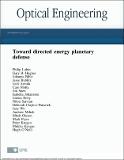Toward directed energy planetary defense
Author(s)
Lubin, Philip; Hughes, Gary B.; Bible, Johanna; Bublitz, Jesse; Arriola, Josh; Motta, Caio; Suen, Jon; Johansson, Isabella; Riley, Jordan; Sarvian, Nilou; Clayton-Warwick, Deborah; Wu, Jane; Milich, Andrew; Oleson, Mitch; Pryor, Mark; Krogen, Peter Ra; Kangas, Miikka; O’Neill, Hugh; ... Show more Show less
DownloadLubin-2014-Toward directed ener.pdf (6.688Mb)
PUBLISHER_POLICY
Publisher Policy
Article is made available in accordance with the publisher's policy and may be subject to US copyright law. Please refer to the publisher's site for terms of use.
Terms of use
Metadata
Show full item recordAbstract
Asteroids and comets that cross Earth’s orbit pose a credible risk of impact, with potentially severe disturbances to Earth and society. We propose an orbital planetary defense system capable of heating the surface of potentially hazardous objects to the vaporization point as a feasible approach to impact risk mitigation. We call the system DE-STAR, for Directed Energy System for Targeting of Asteroids and exploRation. The DE-STAR is a modular-phased array of kilowatt class lasers powered by photovoltaic’s. Modular design allows for incremental development, minimizing risk, and allowing for technological codevelopment. An orbiting structure would be developed in stages. The main objective of the DE-STAR is to use focused directed energy to raise the surface spot temperature to ∼3000 K, sufficient to vaporize all known substances. Ejection of evaporated material creates a large reaction force that would alter an asteroid’s orbit. The baseline system is a DE-STAR 3 or 4 (1- to 10-km array) depending on the degree of protection desired. A DE-STAR 4 allows initial engagement beyond 1 AU with a spot temperature sufficient to completely evaporate up to 500-m diameter asteroids in 1 year. Small objects can be diverted with a DE-STAR 2 (100 m) while space debris is vaporized with a DE-STAR 1 (10 m).
Date issued
2014-02Department
Massachusetts Institute of Technology. Department of Electrical Engineering and Computer ScienceJournal
Optical Engineering
Publisher
Society of Photo-Optical Instrumentation Engineers (SPIE)
Citation
Lubin, Philip, Gary B. Hughes, Johanna Bible, Jesse Bublitz, Josh Arriola, Caio Motta, Jon Suen, et al. “Toward Directed Energy Planetary Defense.” Opt. Eng 53, no. 2 (February 18, 2014): 025103. SPIE ©2014.
Version: Final published version
ISSN
0091-3286